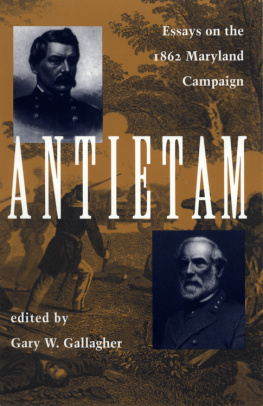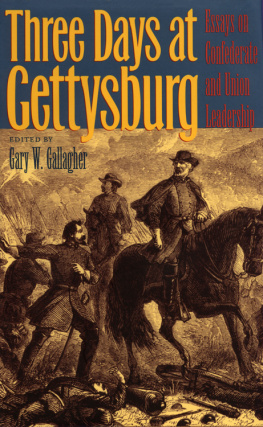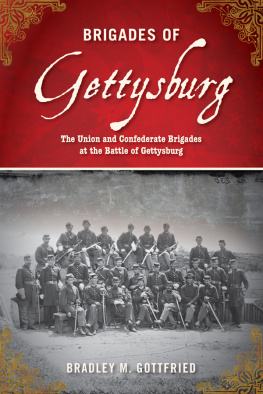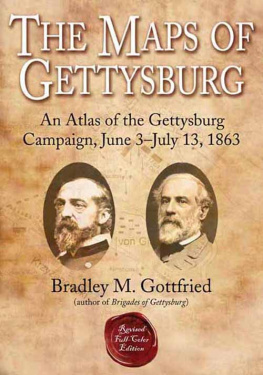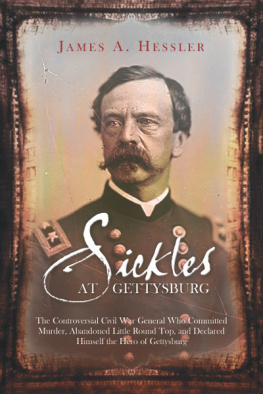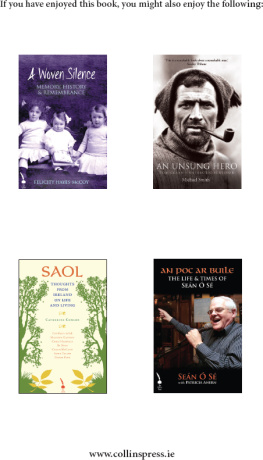1994 The University of North Carolina Press
All rights reserved
Manufactured in the United States of America
The paper in this book meets the guidelines for permanence and durability of the Committee on Production Guidelines for Book Longevity of the Council on Library Resources.
Library of Congress Cataloging-in-Publication Data
The Third day at Gettysburg and beyond / edited by Gary W. Gallagher.
p. cm. (Military campaigns of the Civil War)
Includes bibliographical references and index.
ISBN 0-8078-2155-1 (cloth : alk. paper).
1. Gettysburg (Pa.), Battle of, 1863. I. Gallagher, Gary W. II. Series.
E475.53.T56 1994
973.7349dc20 94-752
CIP
98 97 96 95 94 5 4 3 2 1
THIS BOOK WAS DIGITALLY PRINTED.
INTRODUCTION
This collection of essays addresses topics broadly related to the third day at Gettysburg. It inaugurates the Military Campaigns of the Civil War series, which will bring modern scholarship to bear on controversial issues and leaders, explore previously ignored dimensions of various campaigns and battles, and combine interpretation and fresh research in ways designed to benefit both professional historians and interested lay readers. In ranging over a spectrum of subjects, these six essays illuminate some of the ways in which campaigns influenced the civilian sphere and how expectations from home in turn affected men in the armies. Such connections often remain obscure in the literature on the Civil War. Writers interested in campaigns too often have treated their subjects as if the armies fought in antiseptic isolation from political or social forces; similarly, those interested in the societies behind the lines frequently have managed to explore the war years without mentioning the vast armed struggles waged by Union and Confederate armies. The result has been a bifurcated view of the war that can distort or obscure as much as it reveals. Volumes in the Military Campaigns of the Civil War series, while usually emphasizing leadership, tactics, and strategy, will seek always to place operations within the wider context of the war.
The third day at Gettysburg presents a number of interesting points of departure. As the final violent spasm of Lees raid into Pennsylvania, fighting on July 3 set the stage for Confederate retreat and subsequent attempts to make sense of what had happened over the preceding month. The first essay looks at how men within the Army of Northern Virginia and Confederate civilians viewed the campaign in July and August 1863. Did they see Gettysburg as a major turning point for Lee and his army? Did they pair it with the surrender of John C. Pembertons forces at Vicksburg as comparable disasters boding ill for the future of the Confederacy? Questioning the dominant interpretation of Gettysburg as a debacle that spread gloom across the South, this essay suggests a far more muted contemporary Confederate reaction to the campaign in Pennsylvania.
The relationship between R. E. Lee and James Longstreet has engaged the attention of several generations of students interested in Gettysburg. Longstreet stood at the center of the great postwar debate among former Confederates searching for explanations of southern defeat. The principal villain for Jubal A. Early and other Lost Cause writers, Longstreet defended himself so ineptly that his stock, already low across the South by the 1870s, dropped to a point where many blamed him for the debacle at Gettysburg and by extension the failure of the Confederacy. William Garrett Piston examines Lees and Longstreets respective plans for the third days battle, emphasizing the meager available sources and the consequent difficulty of reaching firm conclusions. His reading of the evidence spares neither Lee nor Longstreetthough readers comfortable with views inspired by the Lost Cause school of authors, which remain widely held more than a century after their first appearance, likely will find Pistons essay unsettling.
Longstreets assault against the center of the Union line formed the centerpiece of the third days battle at Gettysburg. Easily the most famous infantry attack in American history, it has come to symbolize doomed courage in the face of overwhelming odds. Carol Reardon demonstrates that Picketts Charge provoked acrimony in the Confederacy almost immediately, and that during the ensuing decades ex-Confederates waged a literary war to control public perceptions of the military moment hailed as the high water mark of the Confederacy. Passionate debates about which Confederate units went farthest, retreated first, suffered the heaviest losses, and either supported or failed to support other units filled articles and books that in time formed a subliterature on Gettysburg. In charting the ebb and flow of claims and counterclaims among Virginians and those from other southern states, Reardon traces the process by which layers of myth and distortion adhered to a skeleton of truth about an assault that remains imperfectly understood.
The strikingly similar careers of two of George E. Picketts brigadiers are the subject of Robert K. Kricks biographical essay. The war produced few more arresting images than that of Brig. Gen. Lewis Addison Armistead, his hat at sword point, struggling across the stone wall on Cemetery Ridge before receiving a mortal wound within Union lines. Brig. Gen. Richard Brooke Garnetts last moments were scarcely less dramatica mounted figure in open view of thousands of Union soldiers looking for targets, he toppled from his horse with a mortal wound just a few dozen paces short of the northern lines. Recounted endlessly over the years (and in Armisteads case portrayed by dozens of artists), the final moments of these two Virginia soldiers loom prominently in the catalog of memorable vignettes from Gettysburg. Yet the literature contains virtually nothing of substance on either man apart from their roles on July 3, 1863. Kricks essay, based on a rigorous search through materials in the National Archives and elsewhere, offers the first substantial treatment of Armisteads and Garnetts larger military careers. In the course of tracing the professional lives of his subjects, Krick lays to rest some durable myths about the men, reveals a good deal about service in the antebellum United States Army, and underscores the potential for reconstructing at least the public dimension of individuals who left scant literary remains.
The Federal soldiers who turned back Picketts Charge never have received the attention accorded their Confederate opponents. Robert L. Bee focuses on one of those defenders, Sgt. Benjamin Hirst of the 14th Connecticut, who left revealing letters relating to the third day at Gettysburg. Although instructive as documents containing details about the activities of the 14th Connecticut, the letters hold greater promise as evidence about a northern soldiers attitudes toward the war, his relationship with comrades, and the importance of ties to his family and neighbors back in Connecticut. Informed by recent scholarship on common soldiers, Bees analysis of Hirsts letters reveals how antebellum attitudes, prior experiences during the war, and a desire to satisfy expectations of relatives and friends affected both Hirsts behavior on July 3 at Gettysburg and his subsequent written accounts of the battle.
A. Wilson Greene closes the volume with an examination of George Gordon Meade during the eleven days following the repulse of Long-streets assault. Should Meade have launched a counterattack on July 3? Did his timidity permit Lee to reach the Potomac unmolested? And why did he fail to strike at the Army of Northern Virginia as it lay pinned against that flooded river for several days? Most writers have been hard on Meade. Indeed, some have suggested that he frittered away an opportunity to inflict serious, perhaps even mortal, damage to Lees army. Greene suggests that Abraham Lincolns manifest unhappiness with the generals pursuit of Lee has colored virtually all later assessments. Drawing on testimony from the principal Federal officers, as well as a range of other sources, Greene concludes that Meades opportunities often have been exaggerated and his blunders magnified. The Union commander might have accomplished more, concedes Greene, but overall he managed the Army of the Potomac well in the wake of Gettysburg.


